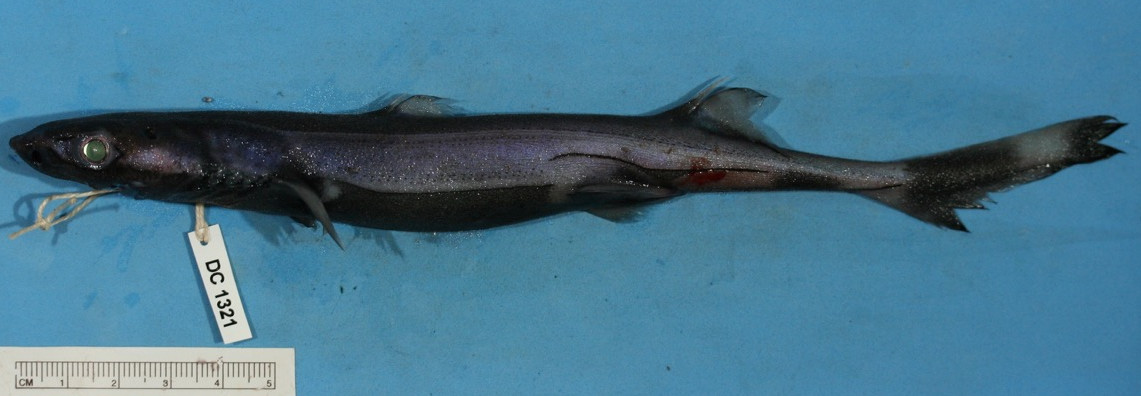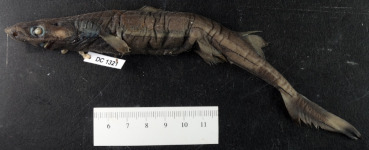Etmopterus marshae
Ebert & Van Hees, 2018
Marsha’s Lanternshark
Classification: Elasmobranchii Squaliformes Etmopteridae
Reference of the original description
Etmopterus marshae sp. nov, a new lanternshark (Squaliformes: Etmopteridae) from the Philippine Islands, with a revised key to the Etmopterus lucifer clade. Zootaxa, 4508(2), 197–210
Etmopterus marshae sp. nov, a new lanternshark (Squaliformes: Etmopteridae) from the Philippine Islands, with a revised key to the Etmopterus lucifer clade. Zootaxa, 4508(2), 197–210
Description :
Citation: Etmopterus marshae Ebert & Van Hees, 2018: In: Database of modern sharks, rays and chimaeras, www.shark-references.com, World Wide Web electronic publication, Version 12/2025
Please send your images of "Etmopterus marshae" to info@shark-references.com

Etmopterus marshae Ebert & Van Hees, 2018, lateral view of holotype (PNM 15353, male 213 mm TL), fresh © Dave Catania, California Academy of Sciences

Etmopterus marshae Ebert & Van Hees, 2018, lateral view of holotype (PNM 15353, male 213 mm TL), fresh © Dave Catania, California Academy of Sciences
Common names
 Marsha’s Lanternshark
Marsha’s Lanternshark
 Marsha’s Lanternshark
Marsha’s Lanternshark
Short Description
Original Diagnosis of EBERT & VAN HEES, 2018 [26759]: Etmopterus marshae is a relatively small, slender species of linear–denticled Etmopterus that can be separated from its closest congeners within the E. lucifer clade by a combination of characteristics including the length of its luminescent lateral flank marking branches being relatively equal in length; only three other species have anterior and posterior flank branches about equal in length. The new species can be separated from the other species with relatively equal branch lengths, E. burgessi Schaaf-Da Silva & Ebert, 2006, E. evansi Last, Séret & Burgess, 2002, and E. pycnolepis Kotlyar, 1990, by a combination of characteristics including a whitish cheek blotch, a purplish lateral body coloration sharply becoming black below line between pectoral and pelvic fins, a distinct pattern of paired dashes along the upper body and between pectoral and pelvic fins, dark and light banding pattern on its caudal fin, and central and upper caudal marking lengths distinctly different from these other three closely related species.
Original Diagnosis of EBERT & VAN HEES, 2018 [26759]: Etmopterus marshae is a relatively small, slender species of linear–denticled Etmopterus that can be separated from its closest congeners within the E. lucifer clade by a combination of characteristics including the length of its luminescent lateral flank marking branches being relatively equal in length; only three other species have anterior and posterior flank branches about equal in length. The new species can be separated from the other species with relatively equal branch lengths, E. burgessi Schaaf-Da Silva & Ebert, 2006, E. evansi Last, Séret & Burgess, 2002, and E. pycnolepis Kotlyar, 1990, by a combination of characteristics including a whitish cheek blotch, a purplish lateral body coloration sharply becoming black below line between pectoral and pelvic fins, a distinct pattern of paired dashes along the upper body and between pectoral and pelvic fins, dark and light banding pattern on its caudal fin, and central and upper caudal marking lengths distinctly different from these other three closely related species.
Dentition
Teeth dissimilar in upper and lower jaw; upper teeth multicuspid in three functional series, functional teeth in lower jaw unicuspid in single series, with at least two series of replacement teeth in upper and lower jaw; multicuspid upper teeth small, perpendicular, with strong central cusp flanked by one or two lateral cusplets on each side, decreasing size distally; first lateral cusplet about one-half height of central cusp, second lateral cusp (if present) much reduced; teeth in lower jaw fused into single row, blade-like, oblique, slightly erect cusp. Tooth count in first row of upper jaw 30 (30–36) and in first row of lower jaw 34 (30–38). [26759]
Teeth dissimilar in upper and lower jaw; upper teeth multicuspid in three functional series, functional teeth in lower jaw unicuspid in single series, with at least two series of replacement teeth in upper and lower jaw; multicuspid upper teeth small, perpendicular, with strong central cusp flanked by one or two lateral cusplets on each side, decreasing size distally; first lateral cusplet about one-half height of central cusp, second lateral cusp (if present) much reduced; teeth in lower jaw fused into single row, blade-like, oblique, slightly erect cusp. Tooth count in first row of upper jaw 30 (30–36) and in first row of lower jaw 34 (30–38). [26759]
Remarks
shark-references Species-ID=15238;
shark-references Species-ID=15238;


















